#Bucaneros
Explore tagged Tumblr posts
Text
Notas para la Historia Dominicana ‐ Las Devastaciones 1605-1606: Capítulo II
¡Bienvenidos a un nuevo capitulo de este episodio apasionante de la historia en la isla Española, las decisiones tomadas en aquellos fatídicos días no solo arruinarán la colonia y sus habitantes, también repercutirán hasta nuestros días! La devastación llevada a cabo por Ossorio no se limitó a unas pocas poblaciones; se extendió por toda la extensión que alguna vez fue el plan de colonización…

View On WordPress
#Antonio Osorio#Bucaneros#Casa Contratación Sevilla#Colonia#Contrabando#Dávila y Padilla#Devastaciones#Devastaciones de Osorio#España#Francia#Gobernador Osorio#Historia#Holanda#Inglaterra#Osorio#Ovando#Piratas#Principal#Santo Domingo#Siglo XVII
0 notes
Text
¡Los mejores bucaneros del manga y anime están en la lista! 🌊💥🏴☠️ Una selección de los piratas más icónicos 🏴☠️👑
¡Atención, amantes del manga y anime! 🚨🎉 Acaba de salir el artículo más esperado en mi blog: "Los mejores bucaneros del manga y anime: una lista de los piratas más icónicos" 🏴☠️⚔️ No te lo puedes perder.
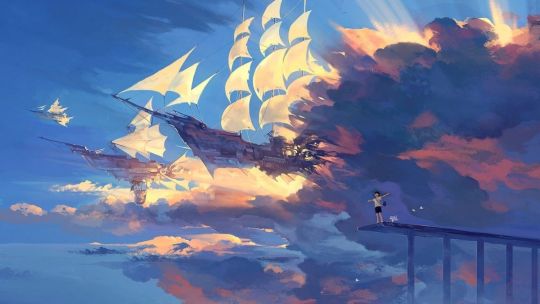
View On WordPress
0 notes
Text

5 notes
·
View notes
Text
Most Beloved NJPW Wrestler Tournament


0 notes
Photo

Bucanero
Los bucaneros eran corsarios que atacaban a los enemigos de su Estado, concretamente España, en el Caribe y en la costa americana (la Tierra Firme del Imperio español) durante todo el siglo XVII. Inicialmente cazadores y luego marineros y soldados, los bucaneros atacaron con éxito puertos españoles como Portobelo, Panamá y Veracruz, pero muy raramente capturaron barcos con tesoros en el mar.
Sigue leyendo...
0 notes
Text
Malta Bucanero 355 ML

La Malta Bucanero es una bebida no alcohólica a base de malta con un sabor dulce y suave. Esta bebida altamente nutritiva y estimulante ha estado en la preferencia por décadas. Su color es muy oscuro con un sabor rico y dulce, se elabora sólo con los mejores ingredientes naturales. Descripción del producto - Bebida a base de malta sin contenido alcohólico. - Sabor dulce malteado de gran valor nutricional. Especificaciones del producto - Contenido de alcohol 0% por volumen - Ingredientes: agua, cebada malteada, azúcar, lúpulo, color caramelo - Durabilidad: 1 año desde el llenado Presentación - Latas 355 ml Read the full article
0 notes
Photo
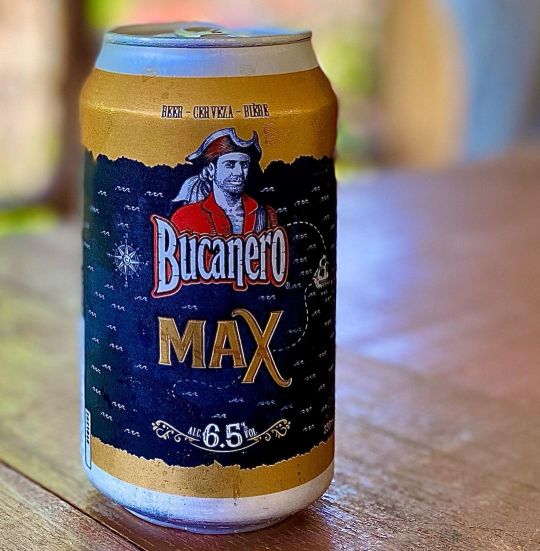
A quien le gusta esta delicia 😋 🍺 😋 #cerveza #beer #bucanero #bucaneromax #elnicho #Cienfuegos #cuba #yoyostravel (at El Nicho - Escambray) https://www.instagram.com/p/CqRkqUEt8tV/?igshid=NGJjMDIxMWI=
0 notes
Text
The Nuclear City
The market, though small, was as lively as any I saw in Cuba. We walked from stall to stall, past vendors selling tropical fruit and sacks of rice. Behind one table a woman sat on the curb, a sack between her thighs, tapping a sieve like an old-timey pan-handler as she separated insects from grains of rice. I bought a portion of fresh, sticky mango slices… realising too late that there was nowhere to wash my hands clean after.
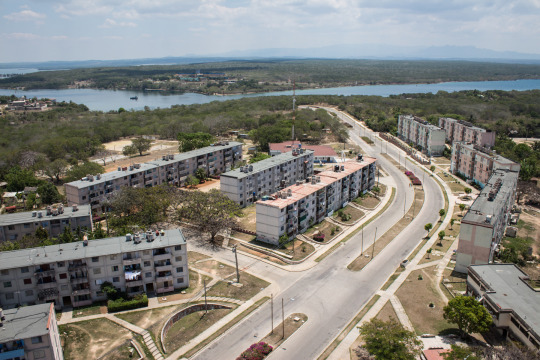
Ciudad Nuclear, Cuba as seen from the 14th floor rooftop of an unfinished apartment block.
The sun was beating down hard so the four of us ducked into the welcome shelter of a bar. We were the only customers; it was dark inside, cool, with flies buzzing lazily around the slow-moving ceiling fan. We ordered a round of beers – Cuban Bucaneros – and I held the cold can up to my baked skull, my temples, then rolled it between my hands allowing the frosty condensation to de-gunk my fruit-sticky fingers. I looked out at the market: an island of humanity, while all around it rose the empty shells of unfinished residential blocks. This handful of stalls was now the social heart of a city once built for thousands, and these people the last stubborn lives to remain amongst the ruins of Ciudad Nuclear.

Thousands of apartments built for construction workers and Soviet nuclear engineers now sit abandoned.
Back in 2014 I shared an article about my visit to an unfinished nuclear power plant in Cuba. It was no more than a concrete shell by the time I saw it, with a dome that made it look almost like a temple, left abandoned on the Caribbean coast.
The site had been built with Soviet money and know-how, and was to be accompanied by a brand new city for power plant workers. The Chernobyl reactors in Ukraine had the workers’ city at Pripyat; the Lithuanian reactor at Visaginas, likewise, had a model socialist city raised up almost overnight in its shadow; and here at Juragua in Cuba, the Soviets helped build ‘Ciudad Nuclear’: in English, simply, ‘Nuclear City.’
The USSR began working on the Cuban nuclear power plant in 1976, and Ciudad Nuclear was opened on 13th October 1982, to house the influx of Soviet scientists and engineers. Located six miles from the plant it was to feature 4,200 homes but the Cuban plant was never finished. Construction ground to a halt in 1989, as the funding dried up and the Soviet Union teetered on the brink of collapse. The intended workers’ city was left in limbo as a result: half finished, only part inhabited, an unsustainable cluster of concrete dwellings on a remote stretch of the Cuban shoreline.

Ciudad Nuclear, Cuba: view from the balcony of a spacious residential complex that never got finished.

A handful of residents still live in Ciudad Nuclear surrounded on all sides by empty blocks, and with the unfinished power plant just visible on the horizon.
I made the journey down to Juragua with friends. We hired a car in Havana, and drove for several hours to reach the site on the south side of the island. We slept in a casa nearby, a sweet little place down by the water’s edge, but on the day of our intended visit to the plant we found the place crawling with security guards. Later we’d come back, and we’d find another way inside the unfinished Juragua NPP – but first we spent an afternoon in Ciudad Nuclear.

A Cuban turkey vulture circles over the quiet streets of Ciudad Nuclear.
Ciudad Nuclear is a peculiar place. I want to call it a ‘ghost town,’ but that wouldn’t be entirely accurate. The handful of citizens who remain here are, for the most part, commuters. Some drive 20 miles to work in Cienfuegos, a larger town with a busy port and industrial sector. Not a lot of Cubans have their own transport though, which means that Ciudad Nuclear – an unfinished, out-of-the-way conurbation with little going on in terms of entertainment or employment – is doomed to a slow depopulation.
Leaving the market, we turned a corner and quickly found ourselves alone. Down the length of Ciudad Nuclear’s main street, only two parked cars and a couple of distant pedestrians were visible. Rounding a corner to the next street we met a small family and a donkey, but the rows of apartment blocks behind them looked desolate and bare.

Empty spaces inside a tower block planned for luxury apartments.
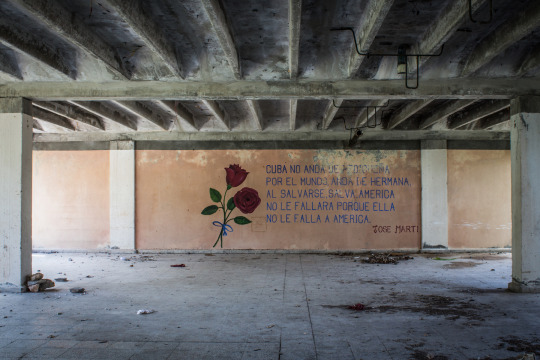
Poetry by José Martí appears on a wall in what might have been intended as a cafeteria.
Save for the occasional sheet flapping in the wind on some third-floor washing line, most of the buildings here seemed to be uninhabited; many looked like they had never been finished, their faded pastel exteriors wrapped around empty cement boxes. Inside one large ground floor space (a shop or a café?) I found a wall decorated with a verse by José Martí, Cuba’s most beloved revolutionary poet:
Cuba no anda de pedigueña Por el mundo, anda de hermana Al salvarse, salva América No le fallará, porque ella No le falla a América.
Poetry always loses a little in translation, but in English it means something like this:
Cuba does not go around the world as a beggar but as a sister By saving herself, she saves the Americas She will not fail, because she will not fail the Americas.
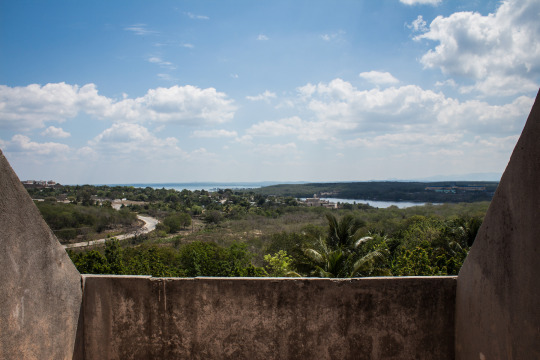
Looking east from Ciudad Nuclear, where a narrow strait connects the Caribbean to the inland Bay of Cienfuegos.
Some of the buildings around Ciudad Nuclear stood near to collapse. I looked inside a few, though there wasn’t much to see. The risk-reward ratio didn’t seem weighted in my favour, so for the most part when I saw ‘Derrumbe’ – ‘Collapse’ – written across a building, I kept away.
Heading back towards the centre we passed a naked tower block, the tallest we’d seen so far. Across its side were painted the words, ‘¡¡Socialismo o Muerte!!’ though it felt like an oddly subversive slogan, given the context. Socialism or Death. This place seemed to have a little bit of both.
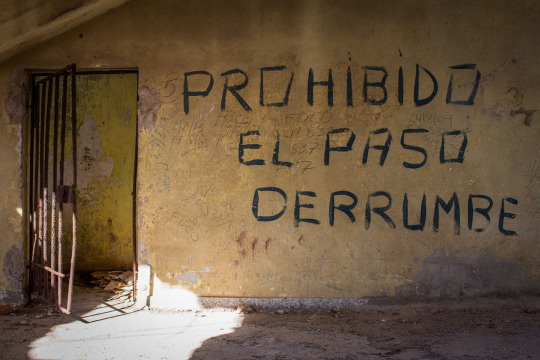

Socialism or Death in Ciudad Nuclear.
Gazing up at that graffitied ruin, I decided I wanted to climb it – to see how Ciudad Nuclear looked from the top. The stairs inside were intact, but there was little else to see inside the 14-floor skeleton; nothing but concrete all the way up. Reaching the top, I walked out of the stairwell onto an open-plan level that fell abruptly away at the edge; no windows, no handrail, just a sudden drop to the street.
Something flapped noisily nearby and I turned, in time to see a large dark bird take flight from its concrete perch on the fourteenth floor balcony. Later I’d be told it was a vulture.
Above the top end of the stairwell, a square hole opened to the rooftop and the sky. It took a bit of a scramble to get up there – balancing on a concrete bannister, catching hold of the ledge above and pulling myself up to the building’s summit – but it was worth the work.
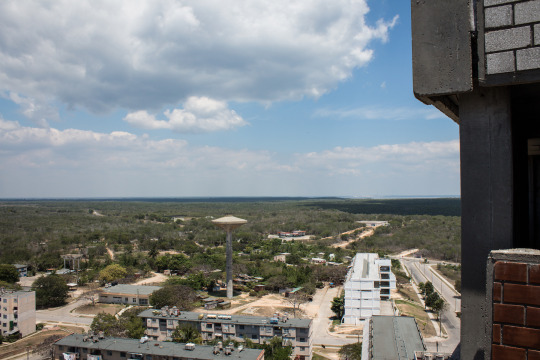
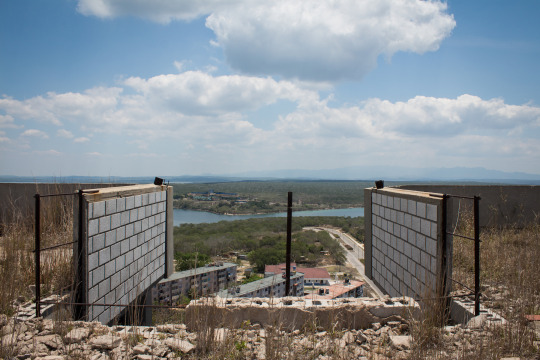
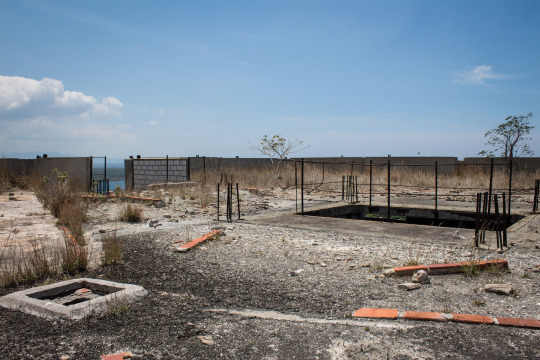
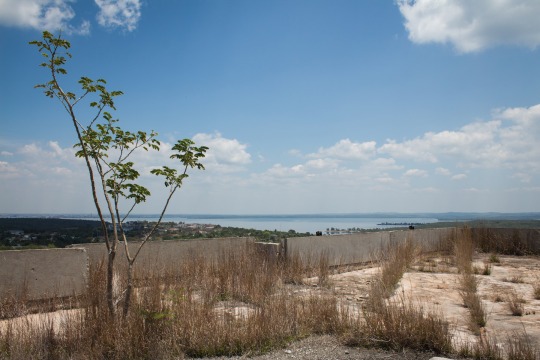
Nature is already reclaiming the rooftops of Ciudad Nuclear, Cuba.

Looking out across the Bay of Cienfuegos from a Ciudad Nuclear rooftop.
Stood up there in the sweltering sun, I traced the shoreline curving into the distance: the beach a ribbon of gold between the water and the forest. Below me the empty streets and unfinished buildings of Ciudad Nuclear fanned out in grid formation, a model city that never quite made it off the drafting table. Meanwhile along the coast, an abandoned 16-floor reactor building rose from the forest like some ancient temple ruin: a concrete mausoleum for the Cuban-Soviet nuclear programme.
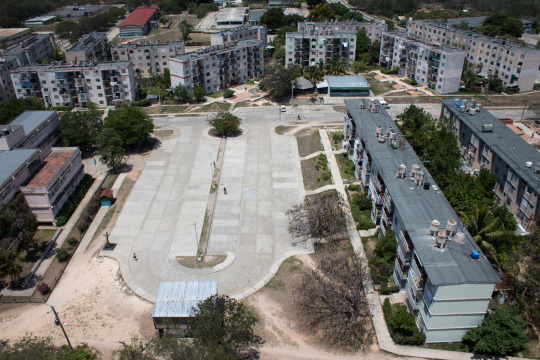
Designed to provide 4,200 homes, this is how the city looks today.

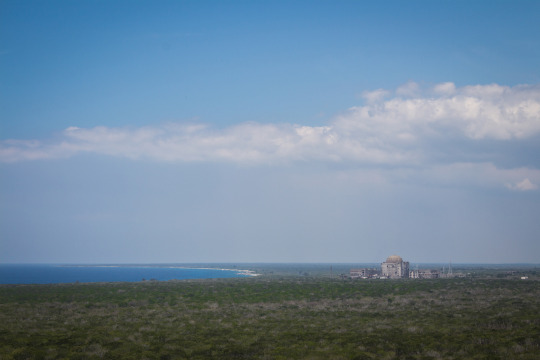
The building that started it all: six miles from the city sits the concrete shell of the Juragua Nuclear Power Plant.
-
Text and photo by Darmon Richter [adapted with permission from an article at [EX UTOPIA]
10 notes
·
View notes
Text

Yul Brynner-Inger Stevens "Los bucaneros" (The buccaneer) 1958, de Anthony Quinn.
16 notes
·
View notes
Text
Taken me this long to get Zandokan Jr to stay still long enough to read his tattoo
ブカネロ
bucanero
Buccaneer
COS HE'S A PIRATE
6 notes
·
View notes
Text
Notas para la Historia Dominicana ‐ Las Devastaciones 1605-1606: Capítulo I
Hace muchos años, en tierras lejanas bañadas por las aguas del océano, se tejía una historia que mezclaba contrabando, riqueza y luchas de poder. El escenario de esta narración era la isla de Santo Domingo, una joya del Caribe que, a medida que el contrabando se extendía como un fuego silencioso, veía crecer su riqueza y prosperidad. El norte y el oeste de la isla se veían transformados por el…

View On WordPress
#Antonio Osorio#Bucaneros#Casa Contratación Sevilla#Colonia#Contrabando#Dávila y Padilla#Devastaciones#Devastaciones de Osorio#España#Francia#Gobernador Osorio#Historia#Holanda#Inglaterra#Osorio#Piratas#Principal#Santo Domingo#Siglo XVII
0 notes
Text
☠️ Hora de zarpar bucaneros! ☠️
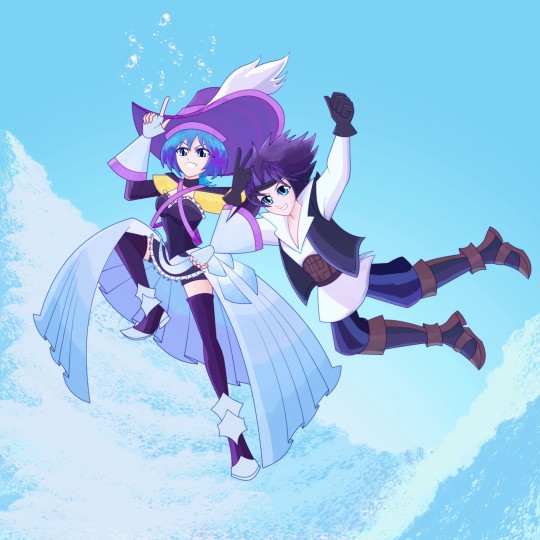
#aqua kingdom hearts#zack fair#ffvii#ffvii crisis core#kingdom hearts birth by sleep#kingdomhearts#kh girls
7 notes
·
View notes
Text
Inicio de mis aventuras. Parte 2
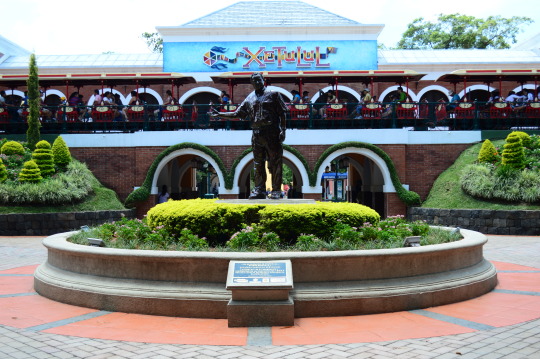
Hooooooooola mis amad@s skylets, su espera de una semana por fin ha llegado a su fin. Ha llegado su turista favorita con lo que tanto ansiaban: la parte 2 del inicio de mis aventuras viajeras, volvamos justo a donde nos quedamos, fin de los anuncios y regresemos a la acción. Tercer y cuarto día. Partimos con dirección a Puerto Arista con la motivación a tope y las energías completamente renovadas para así poder enfrentar el nuevo día de aventuras, aunque la gran fuerza del oleaje en la zona nos frenó ligeramente nuestros ímpetus; Así que nos pusimos en marcha en búsqueda de un lugar mejor: Playa del Sol. Playa del Sol se encontraba a 10 minutos aproximadamente de nuestra ubicación, pero las ganas de disfrutar adecuadamente del mar eran tantas que ni sentimos el tiempo. Llegamos y la vida no tardó nada en agregarle un nuevo detalle a nuestro día pues le quitó sentido al nombre de la zona. Efectivamente, empezó a llover. La lluvia no nos hizo ni cosquillas ya que estábamos anonadados con la belleza de la arena que parecía hecha de cartón mojado… miren, entiendo que esa no es la mejor analogía, pero era un cartón bastante místico y único, además que en retrospectiva *puede* que las gotas caídas del cielo ayudaran a acrecentar ese tono, pero la touriscar de ese día prefirió disfrutar la magia de la situación así que imagínense el objeto color café más oscuro y bonito que se puedan imaginar, de ese tono era la playa.

Nos quedamos hasta altas horas de la noche en el lugar y a pesar de ello decidimos seguir con nuestros planes y dirigirnos a Huixtla que se localizaba a 3hrs de nosotros, terminamos llegando a las 5 de la mañana así que lo primero que hicimos fue encontrar la casa de la cuñada del sobrino de mi madrina y quedarnos profundamente dormidos… por 3 horas. Nos levantamos y sin pensarlo dos veces (ni desayunarL, pero hay sacrificios que uno tiene que hacer por viajar) nos dirigimos a la frontera de Mexico con Guatemala. Tristemente el hambre nos frenó en seco al entrar al país centroamericano, así que buscamos algo de comida (lo que fuese) y nos topamos con dos cosas, la primera: La moneda de allá (quetzales) tiene un valor más alto que el peso mexicano, prácticamente el doble. Segundo: Los tamales guatemaltecos… están horribles con H mayúscula, para empezar, lucen como los oaxaqueños ya que están hechos en hoja de plátano pero una vez que lo partes esta súper aguado, con un sabor muy raro y la carne ni se diga, no la quise ni probar (tenía mucho cuero), por suerte solo compramos uno para cada quien, ese fue todo nuestro desayuno. Para movernos en el país vecino, contratamos una van y de ahí nos llamó la atención visitar un parque temático llamado “Parque Temático Xetulul” al cual llevó 2 horas y media llegar, todos íbamos en calidad de bulto (bien dormidos) excepto mis papás. Llegamos al parque a las 11:30 de la mañana costó alrededor de 125 quetzales la entrada, pasamos a ver TODOS los juegos mecánicos que son bastante únicos a mí parecer, ya después por fin comimos algo increíble: Pollito campero. No sé si fue el hambre o que de verdad el pollo parecía milagroso, pero es el mejor pollo que he comido fuera de casa. El restaurante estaba ambientado como un barco todo bonito, llevaba por nombre “Los bucaneros”. Ya con más energía continuamos recorriendo el parque, es sumamente especial ese parque porque tienen réplicas de otras zonas icónicas del mundo divididas por plazas Alemania, Suiza, España, Francia, Italia, Maya, Chapina, Pueblo Caribeño, Pueblo Fantasía y Pueblo de Guatemala. Las cuales incluyen atracciones como Le Grand Theatre, La Fontana de Trevi, los molinos de Países Bajos, tiendas de Alemania, un castillo en la plaza Española, un juego mecánico con góndolas italianas y mucho más. Compramos una paleta de hielo para el calorcito y salimos del parque fascinados; posteriormente compramos AÚN más pollito campero pero ahora cuando íbamos de vuelta para México porque después de tanta emoción nos dio hambre de nuevo. Llegamos a las 8 de vuelta a nuestro país y ahí concluyó mi día. Y ya. Por ahora es todo lo que tengo para ustedes, no me vayan a pedir más porque esta vez hasta les estoy dando de más, así de mucho me preocupo por ustedes y su salud mental. La próxima semana continuaremos con mi historia chiapaneca, intentaré con todo mí ser darle cierre, pero no prometo nada. Al cabo ya sabrán a esta altura que a mí me encantar hablar y hablar cuando me emociono.
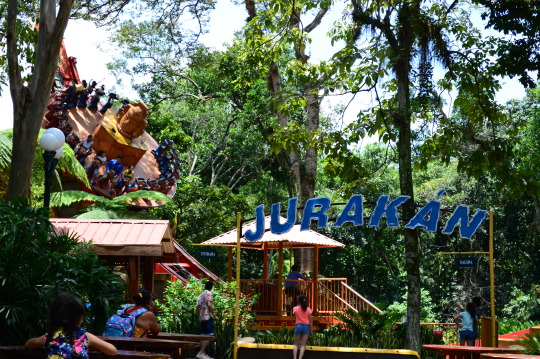
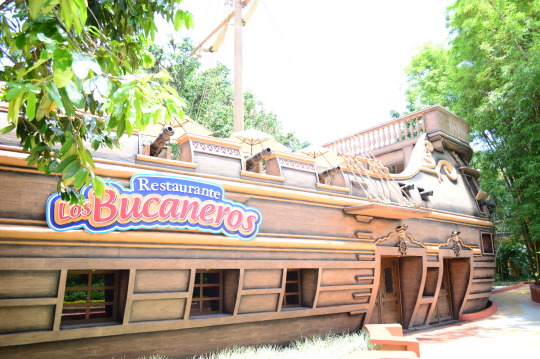
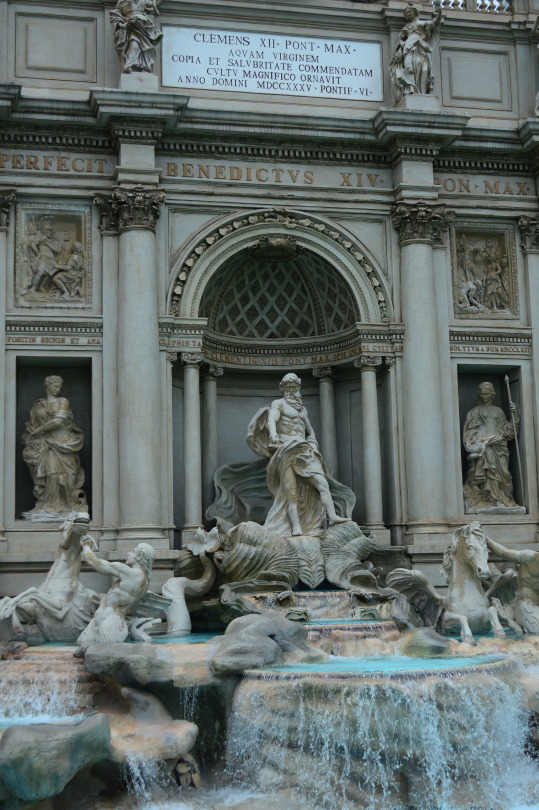
Fotografías de autoría propia.
#tourism#travel#turismo#viajes#guatemala#playa#beach#themepark#holiday#vacaciones#vacanze#fontana di trevi
2 notes
·
View notes
Text
Most Beloved NJPW Wrestler Tournament


0 notes
Text
En la moneda
Esta moneda de oro es un recordatorio de que hubo personas que, con la mitad de lo que hoy tenés en tus manos, se aventuraron hacia lo desconocido, desafiaron los límites establecidos y conquistaron lo inconquistable. Conozco piratas y bucaneros que matarían por tener la mitad de lo que ahora esta en tus manos. Pero estoy seguro de que veras mas allá del valor monetario, miraras el dorado con tu cara reflejada en ella, sonriente, y entenderás el verdadero valor de ella para mi. Y que el aventurero que saco esta moneda de oro sea la prueba, de que los únicos límites que existen son los de la tierra, son los limites por los que caen tripulaciones enteras que lo ultimo que ven es el cielo estrellado formado entre el negro de tu cabello y el blanco de tu piel reflejando la luna... y reflenjandose en ella la luz del sol, una estrella mas que siempre estuvo ahí para verte brillar.
2 notes
·
View notes
Text
Malta Bucanero 355 ML

La Malta Bucanero es una bebida no alcohólica a base de malta con un sabor dulce y suave. Esta bebida altamente nutritiva y estimulante ha estado en la preferencia por décadas. Su color es muy oscuro con un sabor rico y dulce, se elabora sólo con los mejores ingredientes naturales. Descripción del producto - Bebida a base de malta sin contenido alcohólico. - Sabor dulce malteado de gran valor nutricional. Especificaciones del producto - Contenido de alcohol 0% por volumen - Ingredientes: agua, cebada malteada, azúcar, lúpulo, color caramelo - Durabilidad: 1 año desde el llenado Presentación - Latas 355 ml Read the full article
0 notes